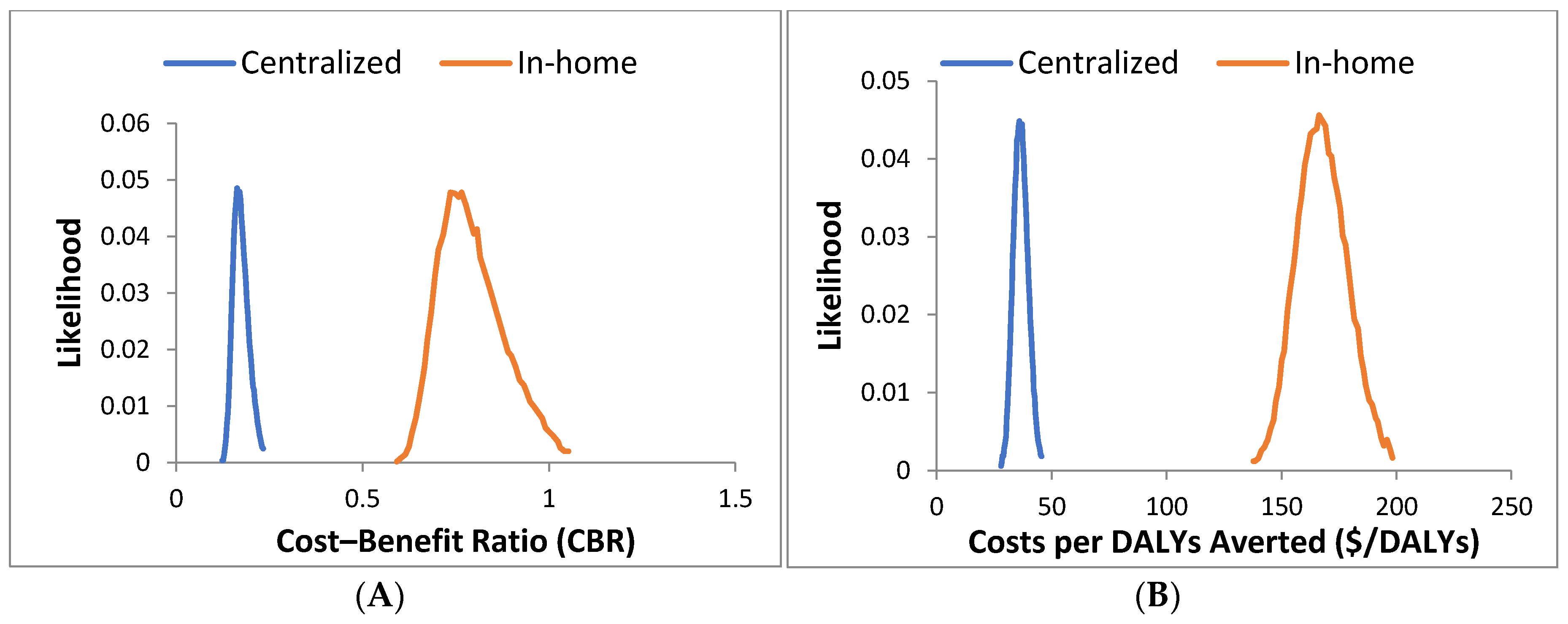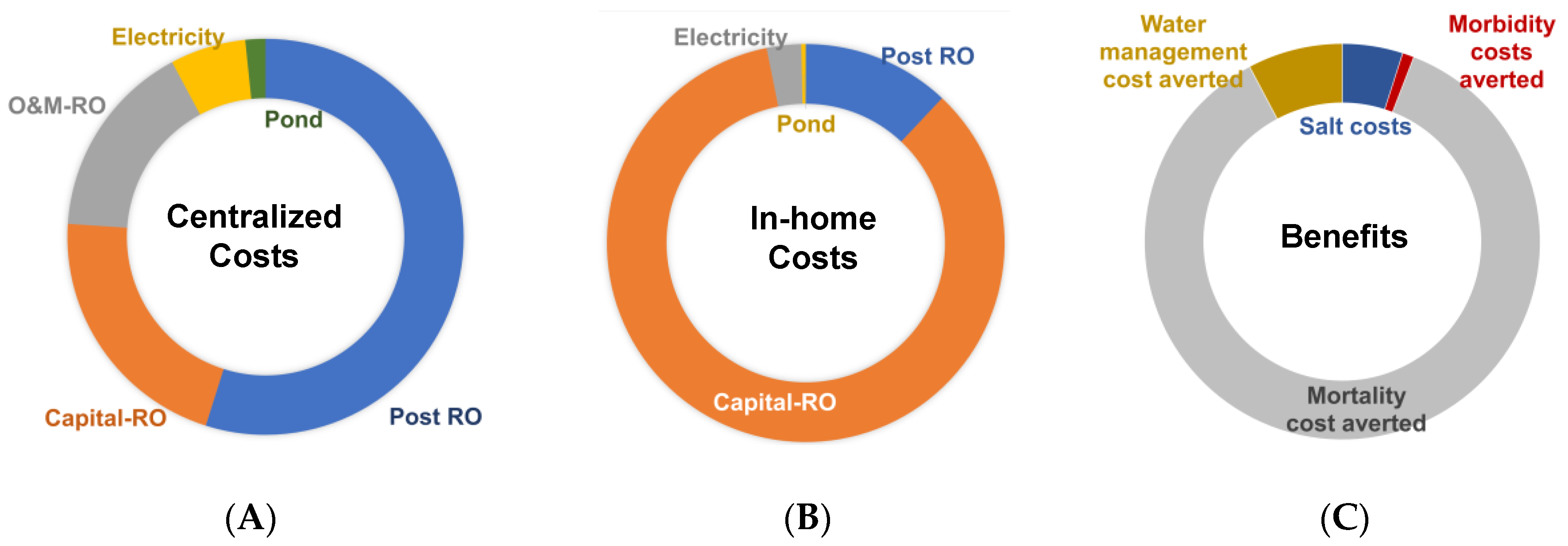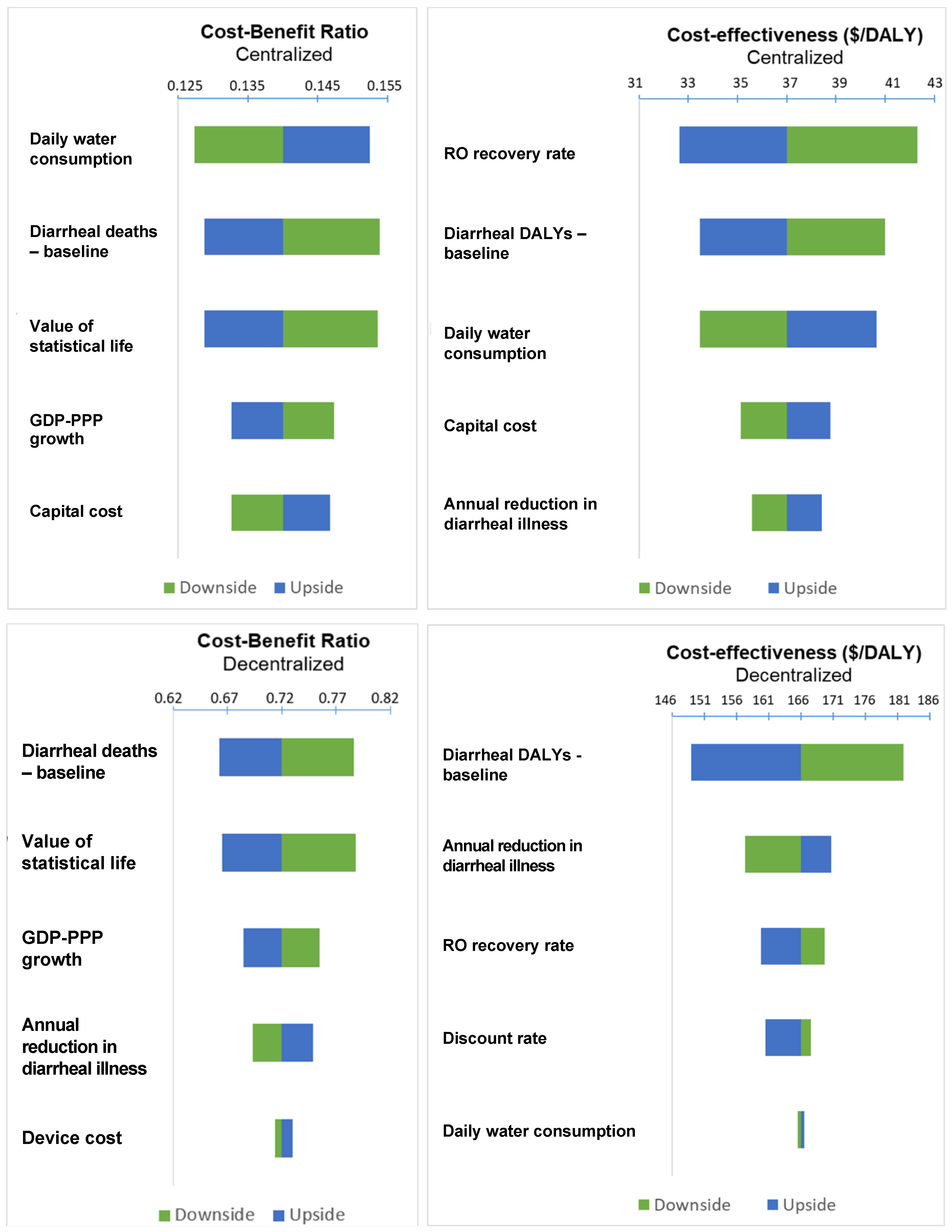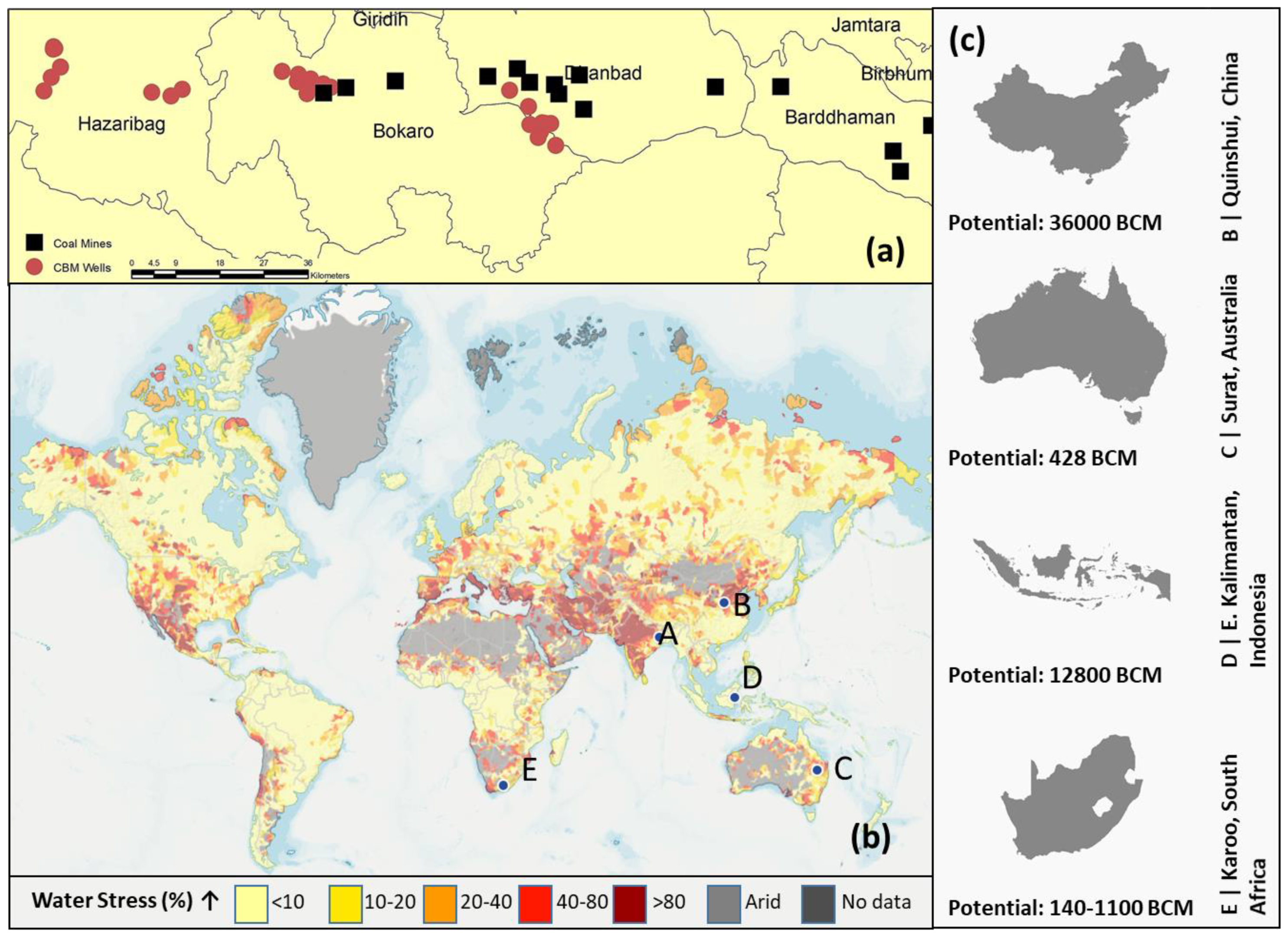Potable Reuse of Coalbed Methane-Produced Waters in Developing Country Contexts—Could the Benefits Outweigh the Costs to Facilitate Coal Transitions?
Abstract
:1. Introduction
2. Methodology
2.1. Overview
2.2. Functional Unit (FU) Calculations
2.3. Estimating Life Cycle Costs
2.4. Estimating Life Cycle Benefits
2.5. Computing Present Value (PV) and Measuring Cost-Effectiveness
- Costs–benefits ratio (CBR): Given by the PV of total costs divided by the PV of total benefits (i.e., Equation (3) divided by Equation (4)).
- Cost per disability-adjusted life years (DALYs) averted ($/DALYs): Indicates what investment is required to achieve a unit decrease in cumulative DALYs over the project lifetime, as computed based on WHO methodologies [39]. This metric is given by PV of total costs divided by cumulative DALYs avoided (i.e., Equation (3) divided by Equation (5)).
3. Results and Discussion
3.1. Cost-Effectiveness Metrics
3.2. Costs and Benefits–Components and Comparisons
3.3. Sensitivity Analysis
3.4. Scalability of Potable-to-Produced Concept
3.4.1. Evaluating Potential Scope for Produced-to-Potable in the Damodar Valley Region
3.4.2. Evaluating Potential Scope Worldwide
4. Conclusions
Supplementary Materials
Author Contributions
Funding
Conflicts of Interest
References
- Roy, J.; Tschakert, P.; Waisman, H.; Halim, S.A.; Antwi-Agyei, P.; Dasgupta, P.; Hayward, B.; Kanninen, M.; Liverman, D.; Okereke, C.; et al. Sustainable Development, Poverty Eradication and Reducing Inequalities; Intergovernmental Panel on Climate Change: Geneva, Switzerland, 2018. [Google Scholar]
- McCollum, D.; Echeverri, L.G.; Busch, S.; Pachauri, S.; Parkinson, S.; Rogelj, J.; Krey, V.; Minx, J.C.; Nilsson, M.; Stevance, A.; et al. Connecting the sustainable development goals by their energy inter-linkages. Environ. Res. Lett. 2018, 13, 033006. [Google Scholar] [CrossRef]
- Schnoor, J.L. Water-Energy Nexus. Environ. Sci. Technol. 2011, 45, 5065. [Google Scholar] [CrossRef] [PubMed]
- Meng, M.; Chen, M.; Sanders, K.T. Evaluating the Feasibility of Using Produced Water from Oil and Natural Gas Production to Address Water Scarcity in California’s Central Valley. Sustainability 2016, 8, 1318. [Google Scholar] [CrossRef] [Green Version]
- Boger, C.; Marshall, J.S.; Pilcher, R.C. Worldwide Coal Mine Methane and Coalbed Methane Activities. In Coal Bed Methane—From Prospect to Pipeline; Elsevier: San Diego, CA, USA, 2014; pp. 351–407. [Google Scholar]
- Singh, U.; Colosi, L.M. Water–energy sustainability synergies and health benefits as means to motivate potable reuse of coalbed methane-produced waters. Ambio 2019, 48, 752–768. [Google Scholar] [CrossRef]
- Nandi, A.; Megiddo, I.; Ashok, A.; Verma, A.; Laxminarayan, R. Reduced burden of childhood diarrheal diseases through increased access to water and sanitation in India: A modeling analysis. Soc. Sci. Med. 2017, 180, 181–192. [Google Scholar] [CrossRef] [Green Version]
- Malakar, K.; Mishra, T.; Patwardhan, A. Inequality in water supply in India: An assessment using the Gini and Theil indices. Environ. Dev. Sustain. 2018, 20, 841–864. [Google Scholar] [CrossRef]
- Grubert, E.; Kelly, D.; Rumbelow, B.; Wilson, J. Improving Produced Water Management: A Case Study of Designing an Inland Desalination Pilot Project. In Proceedings of the World Environmental and Water Resources Congress, Austin, TX, USA, 17–21 May 2015. [Google Scholar]
- Nair, M.; Kumar, D. Water desalination and challenges: The Middle East perspective: A review. Desalin. Water Treat. 2013, 51, 2030–2040. [Google Scholar] [CrossRef]
- Ren, D.; Colosi, L.M.; Smith, J.A. Evaluating the Sustainability of Ceramic Filters for Point-of-Use Drinking Water Treatment. Environ. Sci. Technol. 2013, 47, 11206–11213. [Google Scholar] [CrossRef]
- Editorial Board. RO membranes and components market is growing at 10.5% CAGR. Membr. Technol. 2015, 2015, 4. [Google Scholar] [CrossRef]
- Standing Committee on Petroleum and Natural Gas. Production of Coalbed Methane—Fourteenth Report; Lok Sabha Secretariat: New Delhi, Indian, 2016. [Google Scholar]
- Singh, A.K.; Hajra, P.N. Coalbed Methane in India: Opportunities, Issues and Challenges for Recovery and Utilization; Springer Nature: Cham, Switzerland, 2018. [Google Scholar]
- Bureau of Land Management. Powder River Basin Oil and Gas Project: Environmental Impact Statement; US Department of the Interior: Buffalo, WY, USA, 2002; Volume 1.
- Salmachi, A.; Karacan, C.Ö. Cross-formational flow of water into coalbed methane reservoirs: Controls on relative permeability curve shape and production profile. Environ. Earth Sci. 2017, 76, 200. [Google Scholar] [CrossRef]
- CIMFR. Desorption, Adsorption and Simulation Studies for Coalbed Methane Reservoir Analysis in Moonidih Block; Submitted to CMPDI: Dhanbad, Indian, 2010. [Google Scholar]
- Akgul, D.; Çakmakcı, M.; Kayaalp, N.; Koyuncu, I. Cost analysis of seawater desalination with reverse osmosis in Turkey. Desalination 2008, 220, 123–131. [Google Scholar] [CrossRef]
- Singh, U.; Singh, A.K.; Singh, D.B. Coalbed methane-produced water characteristics and insights from the Jharia coalfield in India. Energy Sources Part A Recovery Util. Environ. Eff. 2018, 40, 1897–1909. [Google Scholar] [CrossRef]
- Avlonitis, S.A.; Kouroumbas, K.; Vlachakis, N. Energy consumption and membrane replacement cost for seawater RO desalination plants. Desalination 2003, 157, 151–158. [Google Scholar] [CrossRef]
- Amazon India. Search—Reverse Osmosis. Available online: https://www.amazon.in/s/ref=nb_sb_noss_2?url=search-alias%3Daps&field-keywords=reverse+osmosis (accessed on 2 January 2018).
- Chun, Y.Y.; Lee, K. Environmental impacts of the rental business model compared to the conventional business model: A Korean case of water purifier for home use. Int. J. Life Cycle Assess. 2017, 22, 1096–1108. [Google Scholar] [CrossRef]
- United Nations. Household Size and Composition around the World 2017. Available online: https://www.un.org/en/development/desa/population/publications/pdf/ageing/household_size_and_composition_around_the_world_2017_data_booklet.pdf (accessed on 25 September 2019).
- Singh, U.; Rao, A.B. Integrating SO2 and NOx control systems in Indian coal-fired power plants. Decision 2015, 42, 191–209. [Google Scholar] [CrossRef]
- Tipton, D.S. Mid- Continent Water Management for Stimulation Operations, 2013. Available online: https://www.epa.gov/hfstudy/mid-continent-water-management-stimulation-operations (accessed on 16 July 2018).
- Macedonio, F.; Katzir, L.; Geisma, N.; Simone, S.; Drioli, E.; Gilron, J. Wind-Aided Intensified eVaporation (WAIV) and Membrane Crystallizer (MCr) integrated brackish water desalination process: Advantages and drawbacks. Desalination 2011, 273, 127–135. [Google Scholar] [CrossRef]
- Hossain, M.A.; Rahman, M.M.; Murrill, M.; Das, B.; Roy, B.; Dey, S.; Maity, D.; Chakraborti, D. Water consumption patterns and factors contributing to water consumption in arsenic affected population of rural West Bengal, India. Sci. Total Environ. 2013, 463–464, 1217–1224. [Google Scholar] [CrossRef] [Green Version]
- IIPS. District-Level Household and Facility Survey; Ministry of Health and Family Welfare: New Delhi, Indian, 2008.
- Million Death Study Collaborators. Changes in cause-specific neonatal and 1–59-month child mortality in India from 2000 to 2015: A nationally representative survey. Lancet 2017, 390, 1972–1980. [Google Scholar] [CrossRef]
- Ministry of Health and Family Welfare. Water-Borne Diseases. Press Information Bureau, 2014. Available online: https://pib.gov.in/newsite/printrelease.aspx?relid=106612 (accessed on 25 September 2019).
- Sobsey, M.D.; Stauber, C.E.; Casanova, L.M.; Brown, J.M.; Eliott, M.A. Point of Use Household Drinking Water Filtration: A Practical, Effective Solution for Providing Sustained Access to Safe Drinking Water in the Developing World. Environ. Sci. Technol. 2008, 42, 4261–4267. [Google Scholar] [CrossRef]
- Payment, P.; Siemiatycki, J.; Richardson, L.; Renaud, G.; Franco, E.; Prevost, M. A prospective epidemiological study of gastrointestinal health effects due to the consumption of drinking water. Int. J. Environ. Health Res. 1997, 7, 5–31. [Google Scholar] [CrossRef]
- Shanmugam, K.R. The Value of Life: Estimates from Indian Labour Market. Indian Econ. J. 1997, 44, 105–114. [Google Scholar]
- Greenland, K.; Schmidt, W. Cost of Infection Study Findings: India, 2012. Available online: https://blogs.lshtm.ac.uk/envhealthgroup/files/2015/05/Results-COI-India21Jun12.compressed.pdf (accessed on 16 July 2018).
- Miller, T.R. Variations between Countries in Values of Statistical Life. J. Transp. Econ. Policy 2000, 34, 169–188. [Google Scholar]
- Cropper, M.L.; Guttikunda, S.; Jawahar, P.; Lazri, Z.; Malik, K.; Song, X.; Yao, X. Applying Benefit-Cost Analysis to Air Pollution Control in the Indian Power Sector. J. Benefit-Cost Anal. 2019, 10, 185–205. [Google Scholar] [CrossRef] [Green Version]
- WHO. Country Statistics. 2018. Available online: http://www.who.int/gho/countries/en/ (accessed on 11 May 2018).
- Boysen, D.B.; Boysen, J.E.; Boysen, J.A. Strategic Produced Water Management and Disposal Economics in the Rocky Mountain Region. 2002. Available online: http://www.gwpc.org/sites/default/files/event-sessions/Deidre_B_Boysen_PWC2002_0.pdf (accessed on 16 April 2018).
- WHO. Metrics: Disability-Adjusted Life Year (DALY). World Health Organization. Available online: https://www.who.int/healthinfo/global_burden_disease/metrics_daly/en/ (accessed on 28 October 2019).
- Shillcutt, S.D.; Walker, D.G.; Goodman, C.A.; Mills, A.J. Cost effectiveness in low-and middle-income countries. Pharmacoeconomics 2009, 27, 903–917. [Google Scholar] [CrossRef]
- Cohen, Y.; Semiat, R.; Rahardianto, A. A perspective on reverse osmosis water desalination: Quest for sustainability. AIChE J. 2017, 63, 1771–1784. [Google Scholar] [CrossRef]
- Gomes, M.; Begum, R.; Sati, P.; Dikshit, R.; Gupta, P.C.; Kumar, R.; Sheth, J.; Habib, A.; Jha, P. Nationwide Mortality Studies to Quantify Causes of Death: Relevant Lessons From India’s Million Death Study. Health Aff. 2017, 36, 1887–1895. [Google Scholar] [CrossRef]
- Grosse, S.D. Assessing cost-effectiveness in healthcare: History of the $50,000 per QALY threshold. Expert Rev. Pharmacoecon. Outcomes Res. 2008, 8, 165–178. [Google Scholar] [CrossRef]
- Liu, Y.; Hejazi, M.; Kyle, P.; Kim, S.H.; Davies, E.; Miralles, D.G.; Teuling, A.J.; He, Y.; Niyogi, D. Global and Regional Evaluation of Energy for Water. Environ. Sci. Technol. 2016, 50, 9736–9745. [Google Scholar] [CrossRef]
- Wenten, I.G.; Ariono, D.; Purwasasmita, M.; Khoirudin. Integrated processes for desalination and salt production: A mini-review. In Proceedings of the AIP Conference, Bydgoszcz, Poland, 10 March 2017; Volume 1818, p. 020065. [Google Scholar]
- Annala, L.; Sarin, A.; Green, J.L. Co-production of frugal innovation: Case of low cost reverse osmosis water filters in India. J. Clean. Prod. 2018, 171, S110–S118. [Google Scholar] [CrossRef]
- Singh, A.K. Geoenvironmental Studies; National Geoscience Award Lecture: New Delhi, India, 2013. [Google Scholar]
- ONGC. Environmental Impact Assessment for Development of North Karanpura Coalbed Methane Block (NK-CBM-2001/I) in Jharkhand; Oil and Natural Gas Corporation Ltd.: Bokaro, India, 2013. [Google Scholar]
- ONGC. Exploratory Drilling for Coalbed Methane Gas in Bokaro CBM Block by M/s ONGC; Ministry of Environment and Forests: New Delhi, India, 2009.
- ONGC. Proposed Pilot Development of Coalbed Methane in Central Parbatpur in Jharia CBM Block Bokaro District and Exploratory Drilling in Jharia Block in Bokaro and Dhanbad Districts of Jharkhand by M/s ONGC; Ministry of Environment, Forests and Climate Change: Ranchi, India, 2015.
- Aqueduct. Water Risk Atlas. Available online: https://www.wri.org/applications/aqueduct/water-risk-atlas (accessed on 28 October 2019).





| Component | Unit | Value | Details |
|---|---|---|---|
| Centralized System | |||
| Capital cost for RO | $/m3 treated water | 0.20 | Corresponds to capital cost of 2000 m3/day facility [18]. These costs are levelized. |
| O&M energy consumption for RO | kWh/m3 | 0.45−1.40 | Varies with initial dissolved solids but assumes treatment down to World Health Organization prescribed levels [19]. |
| Non-energy O&M cost for RO | $/m3 | 0.17 ± 10% | [20] |
| Decentralized System | |||
| Initial cost of RO device | US$ | 137−257 | Based on online survey from Amazon India [21]. See Table S1 for list of devices. |
| Power consumption | W | 24−60 | |
| Flow rate | L/h | 9−15 | |
| Lifetime of device | years | 6−8 | Uniform distribution [22]. |
| Family size | 4.0−5.4 | Survey data [23]. Each family is assumed to own one device at a time. | |
| Centralized and Decentralized Systems | |||
| Electricity cost | $/MWh | 48−70 | Based on costs after implementation of new regulatory measures [24]. |
| Water impoundment cost | $/m3 | 5.0−8.1 | Assuming lined impoundment [25]. |
| Wind-aided intensified evaporation and membrane crystallization (WAIV-MCr) cost | $/m3 | 1.19 | Based on [26]. |
| Drinking water requirement | L/person/day | 3.12 ± 1.17 | Based on field surveys in eastern India [27]. |
| Component | Unit | Value | Details/Reference |
|---|---|---|---|
| Reference (without intervention) | |||
| Annual diarrheal mortality rate | Dimensionless | 6.56 × 10−5 | From Million Death Study’s most recent report [29]. |
| Annual diarrheal morbidity rate | Dimensionless | 8 × 10−3 | From government of India’s published data (non-diarrheal waterborne diseases are not included) [30]. |
| Clean water connectivity | % | 62.4–63.7 | Third district-level household survey findings for Dhanbad and Bokaro districts [28]. |
| Post-intervention | |||
| Reduction in diarrheal illness | % | 72 | Based on ceramic filters efficacy from [31]. RO is assumed to be at least as effective as ceramic filters (specifically candle filters) based on comparison of effluent concentrations. |
| Clean water connectivity | % | 100 | Assumed based on our intervention, corresponding to 0.6 disability-adjusted life years (DALYs) per 1000 persons annually. |
| Recontamination Risk | % | 14–40 | Only in centralized configuration [32]. |
| Other parameters | |||
| Value of statistical life | US$ | 4.64 × 106 | Compounding 1997 value of $1.2 million from [33] with gross domestic product purchasing price parity (GDP-PPP) growth of 7% per annum. |
| Cost of one diarrheal case treatment | US$ | 17.61 | Recent estimate in eastern India [34]. Considers medication and in-patient costs only and not loss in working days. |
© 2019 by the authors. Licensee MDPI, Basel, Switzerland. This article is an open access article distributed under the terms and conditions of the Creative Commons Attribution (CC BY) license (http://creativecommons.org/licenses/by/4.0/).
Share and Cite
Singh, U.; Colosi, L.M. Potable Reuse of Coalbed Methane-Produced Waters in Developing Country Contexts—Could the Benefits Outweigh the Costs to Facilitate Coal Transitions? Energies 2020, 13, 154. https://doi.org/10.3390/en13010154
Singh U, Colosi LM. Potable Reuse of Coalbed Methane-Produced Waters in Developing Country Contexts—Could the Benefits Outweigh the Costs to Facilitate Coal Transitions? Energies. 2020; 13(1):154. https://doi.org/10.3390/en13010154
Chicago/Turabian StyleSingh, Udayan, and Lisa M. Colosi. 2020. "Potable Reuse of Coalbed Methane-Produced Waters in Developing Country Contexts—Could the Benefits Outweigh the Costs to Facilitate Coal Transitions?" Energies 13, no. 1: 154. https://doi.org/10.3390/en13010154






